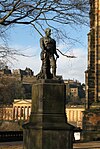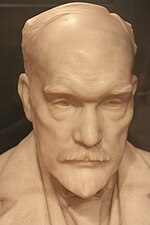Scott Monument
Books in artBuildings and structures completed in 1844Category A listed buildings in EdinburghCultural depictions of Lord ByronCultural depictions of Rob Roy MacGregor ... and 9 more
Cultural depictions of Robert BurnsGothic Revival architecture in ScotlandMonuments and memorials in EdinburghMonuments and memorials to writersObservation towers in the United KingdomPigs in artSculptures of dogsStatues of writersWalter Scott

The Scott Monument is a Victorian Gothic monument to Scottish author Sir Walter Scott. It is the second largest monument to a writer in the world after the José Martí monument in Havana. It stands in Princes Street Gardens in Edinburgh, opposite the Jenners department store on Princes Street and near to Edinburgh Waverley Railway Station, which is named after Scott's Waverley novels.
Excerpt from the Wikipedia article Scott Monument (License: CC BY-SA 3.0, Authors, Images).Scott Monument
Princes Street, City of Edinburgh Old Town
Geographical coordinates (GPS) Address Phone number Website External links Nearby Places Show on map
Geographical coordinates (GPS)
| Latitude | Longitude |
|---|---|
| N 55.952416666667 ° | E -3.1932777777778 ° |
Address
Scott Monument (Sir Walter Scott Monument)
Princes Street
EH2 2DQ City of Edinburgh, Old Town
Scotland, United Kingdom
Open on Google Maps











